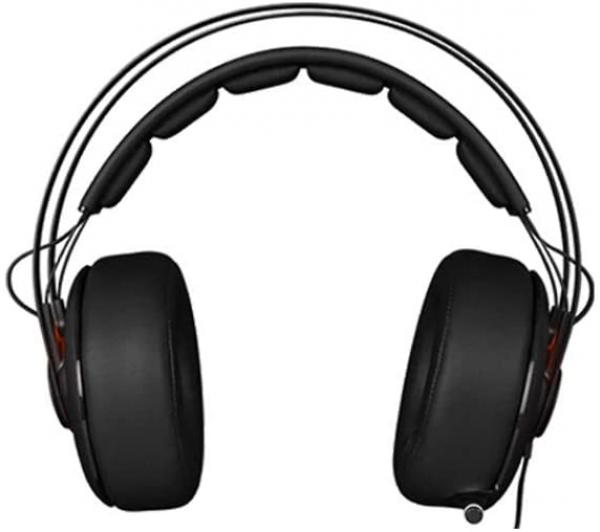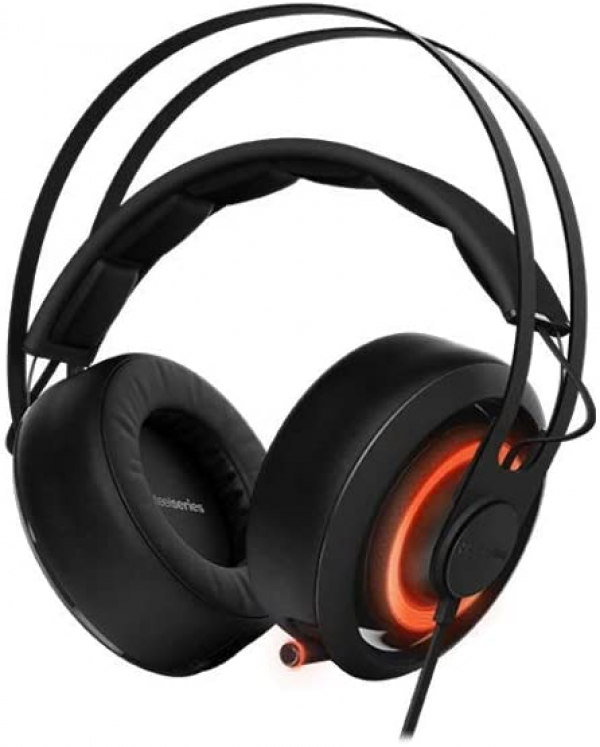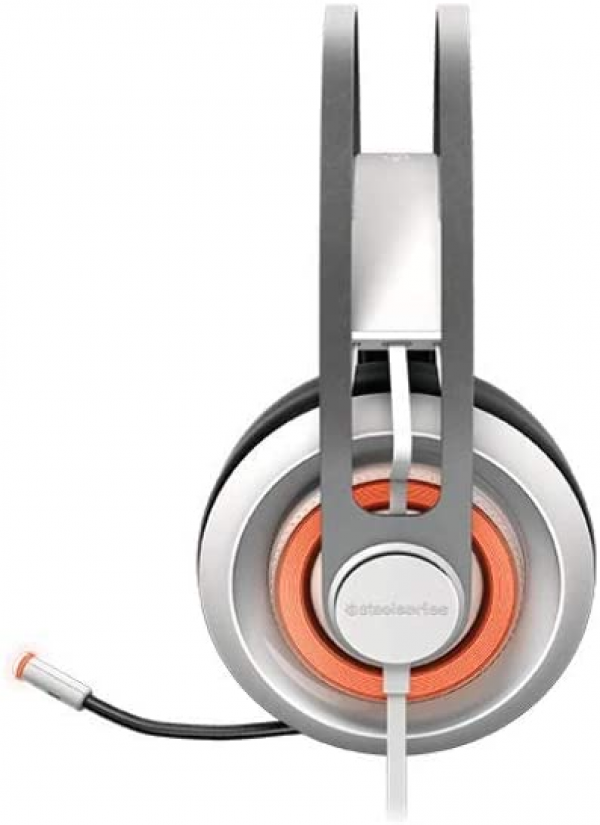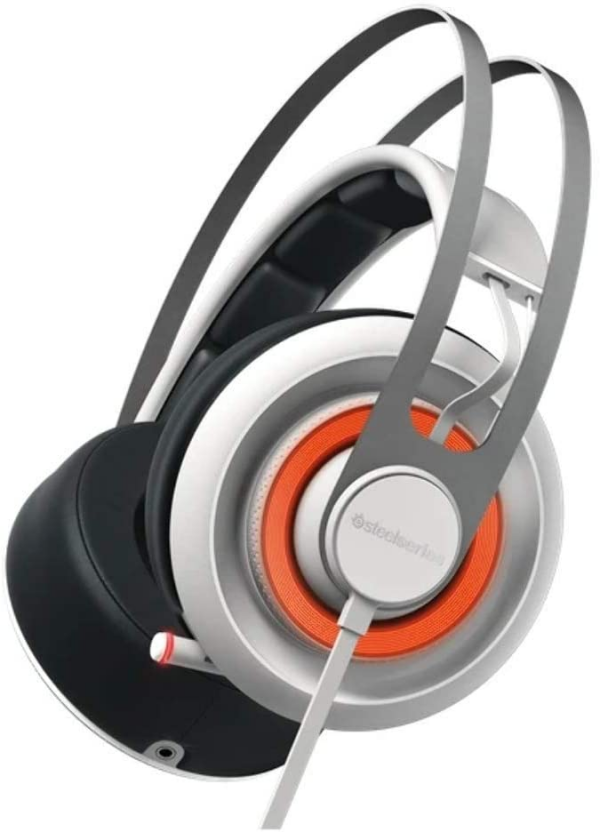SteelSeries
SteelSeries Siberia 650: satisfactory performance ... under conditions
Aprox. 110€ - see price -
In the Siberia family, the 650 (formerly Elite Prism) is the best at Steelseries when it comes to wired gaming headsets. With its atypical design, it promises above all a foolproof comfort in addition to a very good sound quality. These headphones also have a few bonuses such as 7.1 virtual surround, RGB and the Steelseries Engine 3 application. Let's see if it has the qualities necessary to stand up against the competition.
Our review
Presentation
The Siberia 650 has been tested with firmware version 4.55.8.6.

Ergonomics
The Steelseries Siberia 650 is a relatively massive helmet that is adorned with plastic, metal and, in places, rubber. The set is fairly well constructed and looks solid, but the metal arch prevents the helmet from being really flexible. However, certain elements, such as the visible cables, the fixed cable and the rubberized coating of the headband require more special attention over time, especially if the headset accompanies you everywhere.
The Siberia 650 uses a double hoop. The upper is made of metal while the second is made of memory foam / imitation leather and gum rubber. Unfortunately, the latter is very sensitive to contact and resounds at all times, even when you put the headphones on your ears. The ear cups, protected by a plastic shell, are positioned on ball joints which rotate vertically and horizontally. They are covered with the same coating as the arch with a nice thickness, but cannot be removed.
This design offers a heterogeneous comfort experience that is less suitable for larger heads (more than approximately 43 cm). In fact, the headband does not deploy very much, which creates greater pressure on the top of the head. The ear cups rest fairly comfortably on the head, but with a marked feeling of warmth. In some cases, and again for large heads, pressure points are focused at the temple rather than homogeneously around the ear. This small defect also plays on the passive insulation which is even less effective. The Siberia 650 is indeed not what one can call very insulating and it will rather be located in a calm environment to facilitate immersion in a game.
Thanks to a large quantity of adapter and cables, the Siberia 650 is compatible with the vast majority of current platforms. However, all of these adapters use a proprietary connector which means that they have to go through the manufacturer's box if ever something happens to them. The connection begins with a cable with a proprietary connector of approximately 1.2 meters. It is then possible to connect an extension cable of 3 meters, a 4-point mini-jack adapter, a 3-point mini-jack double Y adapter or even a USB / sound card and power adapter for the headphones. It also has a mini-jack input and output as well as a small LED to indicate the operation or action of Dolby mode.
To benefit from RGB light and 7.1, you have to go through the supplied sound card adapter. The Siberia makes it possible to control the volume and the activation of the microphone via two well camouflaged knobs in each earpiece, near the RGB display; better to know. It's not the most obvious thing to find and the quickest to control during the game, but at least the functions are there. Last little gadget, it is possible to share the sound with another headset thanks to the mini-jack connector located in the right atrium.

Software quality
The Steelseries Siberia 650 comes with the SteelSeries Engine 3 software. Tested in version 3.7.1, it is particularly complete and easy to use. It consists of three parts. The first is a tool that brings together and configures all the options available: activation of Dolby, 10-band equalizer with 12 presets, noise reduction and dynamic compression for the microphone, microphone feedback and headphone volume as well as the adjustment of light games RGB .
The second part allows you to add games to manage different assigned profiles. The third is Gamesense, which allows certain game events to be associated with light play. For example, the color that turns from green to red when the character's life drops or when his ammunition is low. On a helmet, the usefulness and the immersion that it could bring are really limited.

Audio
The Steelseries Siberia 650 does not significantly change the game compared to the Siberia V3. It offers an extremely warm and soft reproduction with a very marked sound signature in W.
The bass and low-mids largely cover the rest of the spectrum, which gives a very warm, almost invasive color. A wide variety of sources are impacted: more or less wide percussion, (against) bass, guitars, saxophones, cellos, voices, pianos, etc. In addition, the membranes struggle to move a little on attacks and the signal lacks general precision. Thanks to the small revival in the mediums, the voices manage to get out and remain correctly intelligible. However, the lack of clarity positions them a little behind on the stage, with a small pinched effect, just like the guitars which seem strongly dull. Despite what the significant peak might suggest around 8 kHz, the treble is not so present and there is no sibilance on the horizon, even on songs that flirt with it. The sweetness is also due to the withdrawal of the treble extremes, which causes a lack of overall air.
Curiously, this context does not do too much harm to stereophonic reproduction. It is clearly not the most detailed, especially in terms of depth, but the width is quite good, which makes it possible to read and identify fairly clearly the position of the sources and their direction on a horizontal plane. Virtual surround is not particularly exceptional and ruins the analysis of space a bit, because it adds a room effect that causes the sources to move away.
If you play on PC, you will however be able to benefit from the dedicated application and especially from the 10-band equalizer, which allows in particular to correct certain faults in the frequency response of the Siberia 650. After a good hit of EQ, the scene clearly gains in clarity and readability, even if the reactivity and the precision of the membranes cannot be corrected. This EQ is not very musical, however, because the frequency bands are very tight. So you have to be gentle in corrections. We advise you to slightly dig the area between 64 Hz and 1 kHz by forming a small U, to add a zest of 4 kHz and 16 kHz.
Regarding the proposed equalization modes, avoid them like the plague. Most of them boost bass and low-mids even more or add too much shine, even flicker.
On the distortion side, the Siberia 650 again offers the same thing as its fellow Siberia V3. The distortion is particularly discreet, even at high listening levels. Finally, the headset is not too greedy and can be used with the vast majority of sources, even with smartphones with weak headphone output and without the Siberia sound card.
Microphone
The Steelseries Siberia 650 has a flexible, sliding microphone hidden in the left atrium. It is easy to place in front of the mouth, but is a little harder to store with one hand. It has a small indicator light on the end to warn the user when he is transferred. In the firmware and software version we told you, we were unable to get it to work the first time via USB. This is a known problem since update 3.6.6 and which is resolved either by uninstalling the drivers in the device manager and then unplugging the headphones for 10 seconds, or, in the worst case, by "downgrading" the software version.
After this little mishap, the microphone turned out to be really fair in terms of sensitivity. Indeed, even with the volume at maximum, the captured signal hardly exceeds -20 dB. In more concrete terms, you do not exceed a quarter of the volume indicator on Windows and you have to speak relatively loud to be heard. So no question of playing at night near someone who sleeps. This is a shame, because the software also allows you to activate a fairly effective noise reduction, and above all, something unfortunately too rare, a compression of the signal dynamics. Even with these two options enabled, the average volume of the capture remains low.
Conclusion
The Siberia 650 suffers from some ugly faults related to comfort, cables and sound reproduction. This last point can be improved significantly, but this is only possible on PC; other platforms will have the right to a glut of low frequencies.

